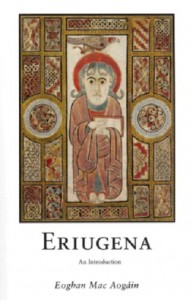ERIUGENA: AN INTRODUCTION
Published in Issue 5 (September/October 2015), Reviews, Volume 23 Iohannes Scotus Eriugena was one of the most fascinating characters of the Middle Ages and Eoghan Mac Aogáin has been able to transmit his charm. His book creates a very clear and captivating portrayal of the Irish philosopher as a multi-sided man: a teacher, a poet, a naturalist and a thinker. His narrative style, which alternates passages from Eriugena’s work with his explanations, makes for an enjoyable read. While academic standards are maintained, he does not lose the gift of a simple and understandable prose, thus creating a book suitable for all readers.
Iohannes Scotus Eriugena was one of the most fascinating characters of the Middle Ages and Eoghan Mac Aogáin has been able to transmit his charm. His book creates a very clear and captivating portrayal of the Irish philosopher as a multi-sided man: a teacher, a poet, a naturalist and a thinker. His narrative style, which alternates passages from Eriugena’s work with his explanations, makes for an enjoyable read. While academic standards are maintained, he does not lose the gift of a simple and understandable prose, thus creating a book suitable for all readers.
Mac Aogáin acknowledges that studying Eriugena also means dealing with his sources. He dedicates a chapter to each one of Eriugena’s spiritual magistri: Martianus Cappella, Gregory of Nyssa, Dionysius the Areo-pagite and Maximus the Confessor. In the first on Martianus, he presents Eriugena as a teacher of liberal arts in the palace school of the emperor. Furthermore, he shows the development of his interest in Neoplatonic philosophy, particularly in its naturalistic and cosmic doctrines. The second chapter is focused on Gregory of Nyssa, to whom Eriugena owes a vast intellectual debt. I strongly agree with Mac Aogáin’s claim of Gregory’s importance for Eriugena’s philosophy. The theology of the Cappadocian father is indeed useful for understanding the unwritten assumptions of Eriugena’s first work, De Praedistinatione, especially regarding the idea of deification. Moreover, it offers an additional explanation for the condemnation of this work by the Latin Church, which considered Eriugena’s doctrines alien to the Latin theology and branded his teachings as heretical. The main turning point for Eriugena’s philosophy is his translation of the corpus areopagiticum that, according to Mac Aogáin, gave him access to Greek doctrines. In fact, Dionysius’s apophatic theology and divine imagery, especially the opposition between light and darkness, influenced greatly the work of Eriugena. The fifth chapter carefully analyses Eriugena’s dependence on Maximus the Confessor’s notions of human as ‘microcosm’ and his ‘five-fold division of everything’. From this analysis, a direct link between the two philosophers is evident; Maximus’s division of nature is explicitly related by Eriugena to his fourfold division of nature, since both of them regard the return of the Creation to God. Mac Aogáin might have dedicated more attention to Origen, who is only briefly mentioned here, a significant source for the Irish philosopher.
The last chapter examines Eriugena’s last works: the writings on St John’s Gospel and the Periphyseon. From a chronological perspective, the writings on the Fourth Gospel should conclude the book, but the importance and comprehensiveness of the Periphyseon justify the author’s decision to conclude with an analysis of Eriugena’s masterpiece. On the Fourth Gospel, Mac Aogáin recognises that Eriugena’s attention is mainly focused on the Prologue. In addition, he identifies the most original and prolific feature of this work in the exegesis of the wilderness as the image of God. The following five chapters of this investigation of Eriugena’s philosophy are dedicated to the five books of the Periphyseon. Examining all of them thoroughly, Mac Aogáin deals with all the main arguments of Eriugena’s work: (1) God; (2) the Primordial Forms; (3) Creation—without the Human; (4) the Human; (5) Salvation. In his chapters on the first book, he explains Eriugena’s fourfold division of nature and his positions on the rational difficulties in apprehending the divine nature, which he believes possible only by means of figurative forms of attribution. In the eighth chapter he successfully presents the Primordial Causes as ‘ideas in the mind of God that bring into existence everything to which existence has been granted’, explaining in clear terms what is a quite complex notion. Here Mac Aogáin discusses also the Trinitarian views of the Irish philosopher, suggesting that Eriugena was too much ahead of his time. If it is true that he was aware of the differences between Western and Eastern theology, I am not convinced that he considered them in utter contrast, as Mac Aogáin seems to suggest. In the following chapter on God’s creation, Mac Aogáin rightly detects the closeness between
Eriugena and the Greek tradition; as a matter of fact, the analogical dialectic proposed by Eriugena has its only precedent in Eastern theology. In the tenth chapter, dedicated to Eriugena’s anthropology, I wonder whether his concerns about the body might have deserved closer investigation. In the chapter on the last book of the eriphyseon, Mac Aogáin explains comprehensively Eriugena’s theory of return to God, who is ‘the goal all Creation is moving towards’, underlining once again his dependence on Maximus’s philosophy.
In the last part of the book, Mac Aogáin gives some additional information on
Eriugena’s life. While his last chapter is en-titled ‘The End of the Story’, the reader has the impression that the story is far from at an end: this incredible philosopher still has a lot to offer our modern world.
















